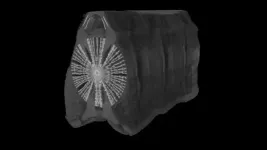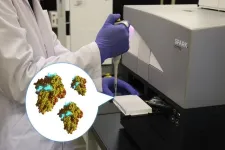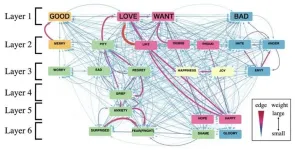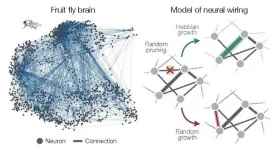(Press-News.org) A new test invented by University of Illinois Chicago researchers allows dentists to screen for the most common form of oral cancer with a simple and familiar tool: the brush.
The diagnostic kit, created and patented by Guy Adami and Dr. Joel Schwartz of the UIC College of Dentistry, uses a small brush to collect cells from potentially cancerous lesions inside the mouth. The sample is then analyzed for genetic signals of oral squamous cell carcinoma, the ninth most prevalent cancer globally.
This new screening method, which is currently seeking commercialization partnerships, improves upon the current diagnostic standard of surgical biopsies — an extra referral step that risks losing patients who sometimes don’t return until the cancer progresses to more advanced, hard-to-treat stages.
“So many patients get lost; they don’t follow up,” said Adami, associate professor of oral medicine and diagnostic sciences. “We’ve tried to keep our focus mainly on early Stage 1 and 2 cancers, so it actually works with the cancers that you want to detect.”
The detection system works by looking for small segments of genetic material called microRNA that regulate the expression of genes. Research conducted by Adami and Schwartz found an expression signature of 40 microRNA sequences that can distinguish between a tumor and normal tissue with over 90% accuracy.
Importantly, their test also worked using epithelial cells, the outermost layer of cells in a patient’s mouth. These cells can be easily collected in less than a minute of gentle brushing — no numbing required — by a dentist or nurse, who then places the brush in a tube of solution and sends it to a lab for microRNA analysis. Results can be returned to the clinic in days with the current version of the diagnostic test.
“We were the first to observe that brush biopsy samples actually work quite well when you use microRNA,” Adami said. “All you need is a good light and the brushes.”
In addition to the convenience of the collection method, the brush biopsy also provides several other advantages, the authors said. Surgical biopsies often collect a mixture of cell types, making subsequent analysis more complicated, and risk spreading cancerous cells to other areas of the mouth. And unlike blood tests that survey generally for genetic signals of cancer, the brush method only collects cells from a single site where treatment can be focused if a malignancy is detected.
“If you compare what we do, which is site-specific targeting of tissue, to the other tests out there, they don’t have a targeting of where the tumors actually are,” said Schwartz, professor of oral medicine and diagnostic sciences. “That makes it harder to start treatment rapidly after detection.”
The inventors hope that the new test will make screening easier to perform, particularly in patient populations that don’t receive regular dental care or have a higher incidence of oral squamous cell carcinoma. For example, Black men have a dramatically lower survival rate with the disease compared with white, Hispanic and Asian men. Usage of the invention in nonclinical settings would allow earlier cancer detection in high-risk populations.
The technology may also eventually be useful in diagnosing other oral diseases through their own unique microRNA signatures, the authors said. To commercialize the test, Adami and Schwartz formed a company called Arphion Diagnostics that has worked with the UIC Office of Technology Management. But they continue to look for business partners to help take the test into dental clinics.
“There are 600 different diseases that occur in the mouth, and a number of these have already been characterized with microRNAs,” Schwartz said. “We could use the same approach and really have a profound impact on these kinds of disease.”
In addition to Adami and Schwartz, research and design of the diagnostic test was conducted by oral and maxillofacial surgeon Dr. Antonia Kolokythas, a key member of the project who helped optimize the methodology and identified and collected brush samples from the first group of patients. The work was supported by grants from the National Science Foundation and the National Cancer Institute. Adami and Schwartz are also members of the University of Illinois Cancer Center.
Written by Rob Mitchum
END
Brush biopsy enables early detection of oral cancer without surgery
2024-01-17
ELSE PRESS RELEASES FROM THIS DATE:
Diets rich in plant protein may help women stay healthy as they age
2024-01-17
Women who consume higher amounts of protein, especially protein from plant-based sources, develop fewer chronic diseases and are more likely to be healthier overall as they age, according to a study led by researchers at the Jean Mayer USDA Human Nutrition Research Center on Aging (HNRCA) at Tufts University and published Jan. 17 in The American Journal of Clinical Nutrition.
Analyzing self-reported data from more than 48,000 women, the researchers saw notably less heart disease, cancer, and diabetes, and cognitive and mental health decline, in those who included more protein in their diets from sources such as fruits, ...
Study uncovers mechanics of machete-like ‘tail-whipping’ in thresher sharks
2024-01-17
Like Indiana Jones, thresher sharks (Alopias spp.) have mastered the art of the whip using their tails. With incredible speed, their long, machete-like tails can slap and stun their prey, allowing them to swallow multiple fish in one fell swoop. Their exceptionally elongated tail, which can often be as long as their entire body, not only makes this particular shark unique, but also a formidable hunter.
Thresher shark “tail-whipping” consists of four phases: preparation, strike, wind-down recovery, and prey collection. Overhead tail slaps begin in the preparation phase by lunging ...
Glowing COVID-19 diagnostic test prototype produces results in one minute
2024-01-17
Cold, flu and COVID-19 season brings that now-familiar ritual: swab, wait, look at the result. But what if, instead of taking 15 minutes or more, a test could quickly determine whether you have COVID-19 with a glowing chemical? Now, in ACS Central Science, researchers describe a potential COVID-19 test inspired by bioluminescence. Using a molecule found in crustaceans, they have developed a rapid approach that detects SARS-CoV-2 protein comparably to one used in vaccine research.
From fireflies ...
Microplastics from natural fertilizers are blowing in the wind more often than once thought
2024-01-17
Though natural fertilizers made from treated sewage sludge are used to reintroduce nutrients onto agricultural fields, they bring along microplastic pollutants too. And according to a small-scale study published in ACS’ Environmental Science & Technology Letters, more plastic particles get picked up by the wind than once thought. Researchers have discovered that the microplastics are released from fields more easily than similarly sized dust particles, becoming airborne from even a slight breeze.
Microplastics, or small bits of plastic less than 5 millimeters long, have appeared everywhere from clouds to heart tissues. And with these plastics’ increasing prevalence in ...
New AI makes better permafrost maps
2024-01-17
LOS ALAMOS, N.M., Jan. 17, 2024 — New insights from artificial intelligence about permafrost coverage in the Arctic may soon give policy makers and land managers the high-resolution view they need to predict climate-change-driven threats to infrastructure such as oil pipelines, roads and national security facilities.
“The Arctic is warming four times faster than the rest of the globe, and permafrost is a component of the Arctic that’s changing really rapidly,” said Evan Thaler, a Chick Keller Postdoctoral Fellow at Los Alamos National Laboratory. Thaler is corresponding ...
New study unveils emotional hubs that exist across languages
2024-01-17
Emotions exert a profound influence on human behavior, prompting extensive explorations in the realms of psychology and linguistics. Understanding central emotions also has practical utility since it can help organizations create messages that resonate better with people. For instance, businesses can enhance their connection with their customers, and non-profits can prompt quicker action by skillfully leveraging the salient emotions in humans.
Colexification is a phenomenon in which the occurrence of a single word is associated with multiple concepts that share semantic relationships. The analysis of colexification is an innovative linguistic method for ...
Childhood stress linked to higher risk of high blood pressure, obesity, diabetes in adults
2024-01-17
Research Highlights:
Consistently high scores of perceived stress during adolescence through adulthood may contribute to worse cardiometabolic health including obesity in young adults..
Researchers suggest the adoption of healthy coping strategies for stress management early in life may help prevent cardiometabolic diseases, from heart disease to Type 2 diabetes.
Embargoed until 4 a.m. CT/5 a.m. ET Wednesday, January 17, 2024
DALLAS, January 17, 2024 — Young adults who reported higher stress during their teenage years to adulthood were more likely to ...
US air pollution rates on the decline but pockets of inequities remain
2024-01-17
Over the last decades, air pollution emissions have decreased substantially; however, the magnitude of the change varies by demographics, according to a new study by Columbia University Mailman School of Public Health. The results indicate there are racial/ethnic and socioeconomic disparities in air pollution emissions reductions, particularly in the industry and energy generation sectors. The findings are published in the journal Nature Communications.
The research provides a national investigation of air pollution emission ...
Fly brain, mouse brain, worm brain: They all network the same
2024-01-17
New York, January 17, 2024 — In all species, brain function relies on an intricate network of connections that allows neurons to send information back and forth between one another, commanding thought and physical activity. But within those networks a small number of neurons share much stronger connections to one another than all the others. These abnormally strong connections—known as “heavy tailed” based on the shape of their distribution—are thought to play an outsized role in brain function.
Researchers ...
Surprisingly simple model explains how brain cells organize and connect
2024-01-17
A new study by physicists and neuroscientists from the University of Chicago, Harvard and Yale describes how connectivity among neurons comes about through general principles of networking and self-organization, rather than the biological features of an individual organism.
The research, published on January 17, 2024 in Nature Physics, accurately describes neuronal connectivity in a variety of model organisms and could apply to non-biological networks like social interactions as well.
“When you’re building simple models to ...





